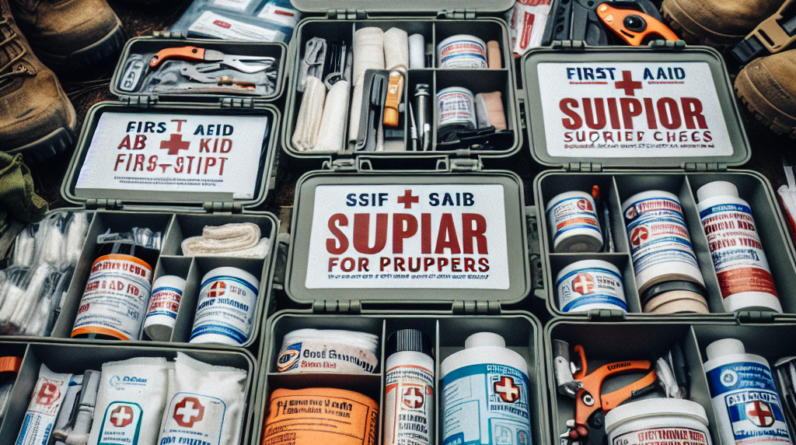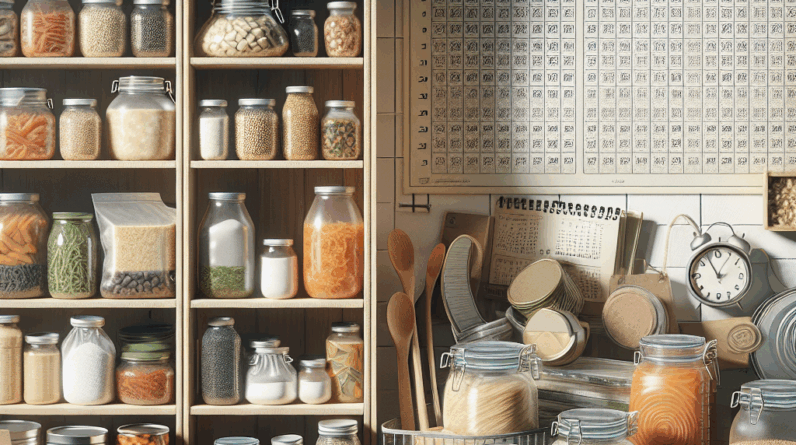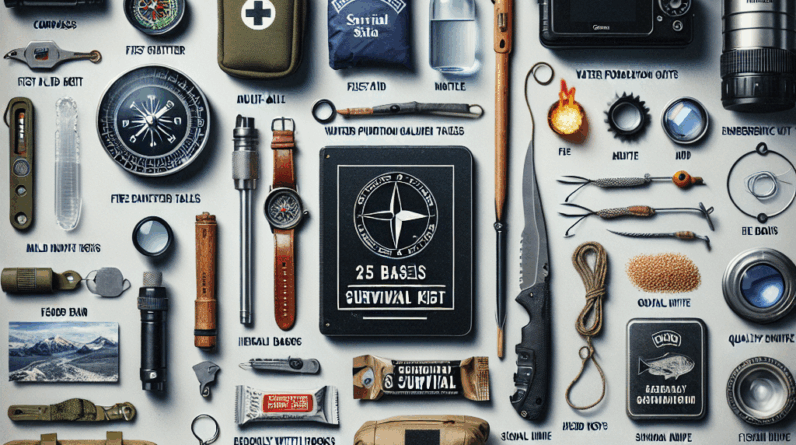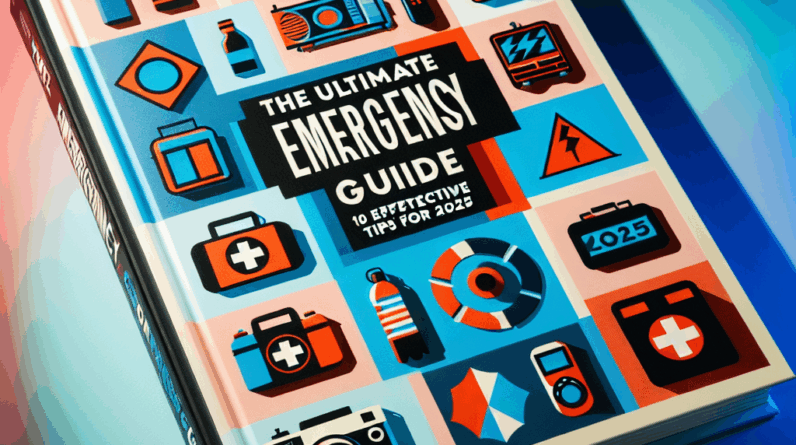
As a seasoned prepper, I know firsthand the importance of being ready for any situation. Whether it’s a natural disaster, a camping trip gone wrong, or just the everyday bumps and bruises of life, a well-stocked first aid kit can be a lifesaver. Today, let’s dive into what I believe are the five essential components you should look for in a first aid kit that caters to preppers.
1. Comprehensive Medical Supplies
When I first started prepping, I realized that a basic first aid kit just wouldn’t cut it. The comprehensive medical supplies are the backbone of any kit.
Basic First Aid Items
The inclusion of items like adhesive bandages, gauze pads, and antiseptic wipes is crucial. These are your everyday essentials. I always ensure that I have a variety of bandages in different sizes because you never know what kind of injury you might face.
Additionally, don’t overlook the importance of a good antiseptic solution. It’s something I consider non-negotiable; you want to prevent infections right from the get-go. Trust me, a small cut can turn into a major headache if not treated properly.
Last but not least, having some medical tape can come in super handy. It might seem basic, but I can’t tell you how often I’ve used it to hold gauzes in place or even to bundle up items for splints.
Medications and Treatments
Along with the basics, consider including a variety of medications. I personally make it a point to stock pain relievers, antihistamines, and even some cold and flu medications in my kit. You never know when allergies might hit or when you’ll feel under the weather in a crisis.
If you have any specific health issues, be sure to include your personal medications as well. It was a lesson learned the hard way when I forgot my basic allergy meds on a trip. Don’t make my mistake!
Also, include items for treating burns like burn gel or aloe vera. It’s not super common, but if it happens, you’ll be glad you were prepared.
Specialty Items for Preppers
For those of us who like to take our prepping a step further, having specialty items is a game-changer. I’ve found that having a trauma kit can be invaluable for handling more serious injuries. Quick clotting agents, sterile gloves, and even triangular bandages can make all the difference.
Another overlooked item is a tourniquet. While it’s rare to need one, in the event of a severe injury, having the ability to stop blood loss is life-saving. I keep one handy in my kit just in case.
Finally, consider adding a CPR face shield. It’s a small, but vital tool that can protect you while providing crucial assistance in emergencies.
2. Compact and Durable Container
Now that we’ve covered what goes inside your first aid kit, let’s talk about the package itself. The right container is essential for keeping your supplies organized and ready.
Size and Portability
When I was picking out my first aid kit, I learned the importance of choosing a container that’s not too bulky but still fits all the essentials. A good rule of thumb is to find a kit that you can easily grab and go with.
Also, think about where you’ll store it. I prefer something that can fit in my backpack or in the trunk of my car. You never know when an emergency will arise, so it’s always best to have it accessible.
Another great option is having a smaller kit for your everyday carry. I keep a compact pouch with basic supplies in my daily bag—just in case!
Waterproof Features
Weather can be unpredictable, and if it pours while you’re out in nature or there’s flooding, you want your supplies to stay dry. I cannot stress enough how much I appreciate having a waterproof or water-resistant container.
Even if you’re not a camper, things like humidity or spills can contaminate your supplies. This is one prep step not to skip.
Check the seals and zippers on your kit; if they’re not robust, look for something better. You want to ensure durability in various terrains and conditions.
Organization and Accessibility
A messy first aid kit can be confusing during a crisis. I learned this the hard way when I went digging through mine during a minor emergency. So, I highly recommend an organized kit with clear compartments.
Labeling can be a lifesaver—pun intended! If you know where everything is and have it sorted, you’ll save precious time when you need it the most.
Also, consider how you pack your items. I like to group similar items together. For example, keeping all the bandages in one area, and all the medications in another makes everything easy to find.
3. User-Friendly Design
Being user-friendly can make all the difference. If the kit isn’t easy to use, all those great supplies can go to waste.
Clear Instructions
Many kits come with some level of manual or instruction booklet. I always make sure mine includes clear instructions for various medical scenarios. It’s essential, especially if you’re helping someone else.
Even if you’re seasoned, refresher cards on basic first aid can be really helpful. I keep mine clipped inside my kit for quick access. In a panicked moment, it’s easy to forget simple steps.
Also, consider the language. If you’re using your kit with others, having instructions in multiple languages can be a real asset.
Ergonomic Design
A kit that’s hard to hold or awkward to open isn’t going to help in a pinch. The design should ideally allow for one-handed operation, especially if you’re in an emergency where your other hand might be occupied.
I prefer a kit that can be opened easily with a single motion. It makes accessing supplies faster and helps cut down on fumbling.
Consider how the contents are stored too. A kit that spills everything when opened is no good. Look for compartments or pockets that keep items separated without chaos.
Get Preparedness and Self-Reliance Tips. Subscribe Now!
Reflective and Bright Colors
In low light or chaotic situations, having a bright, reflective kit can help you locate it quickly. I always go for kits that have vibrant colors or reflective strips.
This can be particularly important in outdoor settings like camping or during power outages. You want to ensure that your kit is visible and easily found.
Some companies even offer custom colors, which can be a fun way to personalize your prep gear. Just remember functionality should be the priority!
4. Regular Updates and Maintenance
Now that you’ve got your kit stocked and ready, let’s chat about upkeep. Regular maintenance can mean the difference between a useful kit and one that’s outdated or ineffective.
Checking Expiration Dates
I can’t tell you how many times I’ve saved myself by regularly checking the expiration dates on items. Medications can lose effectiveness over time, and bandages can dry out if they’re old.
Make it a regular habit to review your kit—I’ve set yearly reminders to keep me on track. It’s not the most exciting task, but I promise you’ll be thankful when you need something, and it’s not expired.
Document the dates to make it easier. I simply create a small checklist of what needs to be replaced or reviewed yearly. It saves you from last-minute scrambles.
Restocking Supplies
If you use something from your kit, replace it as soon as possible. I remember being in a situation where I took a bunch of supplies for a small wound, only to face a bigger issue later without restocking.
Another good idea is to keep a list of what supplies you often use and ensure those are always available. It’s a small tweak that makes a massive difference.
Additionally, consider seasonality. Some items are more useful in the winter than summer (think cold packs or sunburn relief). Adjust your supplies as needed.
Reevaluating Your Needs
As my prepping journey evolved, so have my first aid needs. I sometimes change my kit contents based on new skills I’ve learned or lifestyle changes. Have you taken a first aid course? Perhaps you’ve switched hats and are now a parent—your kit may need a refresh!
Be open to change. It’s a great learning opportunity. I’ve also included items based on specific activities I’ve taken up, like hiking or biking.
The key is to make sure your first aid kit evolves alongside you and your lifestyle. This way, you’ll always be ready, no matter the situation that arises.
5. Customization Based on Personal Needs
Lastly, one size definitely does not fit all when it comes to first aid kits. Personalizing your kit is crucial, as each person may have different health concerns or activities they engage in.
Health Considerations
If you have any chronic conditions or allergies, make sure to include items tailored to your needs. The first time I got a bee sting while camping, I was super thankful I had my epinephrine auto-injector handy.
Similarly, I also ensure I have specific supplies for family members. Everyone’s health needs are different, so it’s essential to cater to the specific ingredients in your group.
Being pro-active about what you might need can save lives. Keep a checklist of essential items for everyone involved to streamline this process.
Activity-Based Additions
What activities are you involved in? Are you a hiker, a cyclist, or someone who enjoys going on long trips? Tailor your kit accordingly. I’ve learned that keeping extra items relevant to specific hobbies can come in handy.
For example, hiking requires things like blister patches and snake bite kits, while biking might need extra items like triage for splitting a helmet during a crash.
Always think ahead! By customizing based on activities, you prepare better and feel more secure when you’re out and about.
Personal Touches
Finally, don’t shy away from including personal touches. You might want to add items that hold sentimental value or that make you feel more comfortable in some scenarios. Things like a small reflective blanket or a favorite solace item can be comforting during stressful times.
Additionally, I find that adding a wallet-sized first aid reference card can be helpful. It’s always handy to have quick instructions on the go!
Ultimately, making the kit personal not only gives you peace of mind, but it gives everyone around you a feeling of security, knowing that you’re prepared.
Frequently Asked Questions
1. What should I include in my first aid kit for prepping?
Be sure to include comprehensive medical supplies (bandages, antiseptics), medications, and specialty items like tourniquets. Don’t forget to consider personal health needs and activities!
2. How do I ensure my first aid kit is portable?
Choose a compact container that isn’t too bulky. Make sure it’s easy to grab and that you can store it conveniently in places like your car or backpack.
3. How often should I check my first aid kit?
I recommend checking your kit at least once a year. However, it’s best to check any time you use an item to ensure you’re always stocked up.
4. Is it necessary to include prescription medications in my first aid kit?
Yes, it’s essential to include any personal medications, especially for chronic conditions. Make sure to regularly check their expiration dates too!
5. Why is personalizing my first aid kit important?
Everyone has unique health needs and activities, so personalizing ensures you have the right supplies for your situations. It makes you better prepared and more confident during emergencies!




